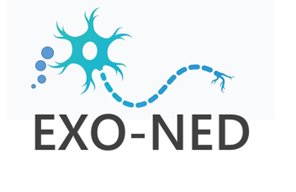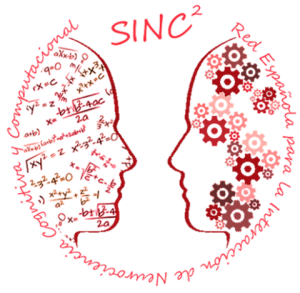Chairs: Lydia Jiménez & Paula Rodriguez & Carlos Matute
Hosted by CJIF SENC
Opening remarks for the Excellent Student Rita Levi Montalcini Award by Lydia Jiménez & Carlos Matute
First Session
Chairpersons: Paula Rodriguez & Sara Mederos
In vivo reprogramming to regenerate aged tissues induced by chronic stress
Sara Borrás-Perna, Universidad Barcelona
Selective GIRK1 deletion in Lhx6 interneurons restores network function and memory deficits in a mouse model of Alzheimer’s disease
Jaime Mulero Franco, Universidad Castilla La Mancha
Activation of notch pathway in brain endothelial cells ameliorates vascular abnormalities in alzheimer’s disease mouse models
Silvia Quiñones Cañete,IBIS, Sevilla
Second Session
Chairpersons: Manuel Valero & Soraya Martín
Decoding THC-related impairments: the role of astrocytic ensembles in the Nucleus Accumbens
Cristina Martín Monteagudo,Instituto Cajal
Neuronal ensembles encoding sensory behavior are defined by astrocyte excitability
Andrea Misol Ortiz,Hospital Parapléjicos Toledo, andreamisol13@gmail.com
Deliberation
Award Ceremony presented by Paula Rodriguez & Manuel Valero
Closing remarks by Lydia Jiménez & Carlos Matute
Organized by: Red Glial Española
– Welcome and Inauguration.
Arantxa Tabernero. Chair of the Spanish Glial Network
SHORT TALKS (Chairs: Maite Solas, José Gómez-Sánchez)
– OPCs’ inflammatory memory as a key factor in remyelination
Sonia Cabeza Fernández. Instituto de Neurociencias UMH-CSIC. Spain.
– Accumulation of PFAS in myelin sheaths: Long-term consequences on myelination and myelin stability.
Victor Valcárcel Hernández. Muséum National d’Histoire Naturelle (CNRS). France.
– Unveiling the dynamic link between proliferation and phagocytic efficiency in brain development: the role of IKAROS
Marco González Domínguez. Achucarro Basque Center for Neuroscience. Spain.
– Beneficial effects of astrocytic GLUT1 ablation in Alzheimer’s disease.
Paula Escalada Matute. Universidad de Navarra. Spain.
– Decoding THC-related impairments: the role of astrocytic ensembles in the nucleus accumbens.
Cristina Martín Monteagudo. Instituto Cajal (CSIC). Spain.
– Neuronal ensembles encoding sensory behavior are defined by astrocyte excitability.
Andrea Misol Ortiz. Hospital Nacional de Parapléjicos. Spain.
LAIA ACARIN AWARD LECTURE (Chair: Juliana M. Rosa)
– Microglia mitochondrial complex I deficiency during development induces glial dysfunction and early lethality.
Nicolás Capelo-Carrasco y Bella Mora Romero. Instituto de Biomedicina de Sevilla. Spain.
PLENARY LECTURE (Chair: Federico N. Soria)
– Microglia modulate neurovascular responses in health and disease
Ádám Dénes. Institute of Experimental Medicine. Hungary.
ASSEMBLY OF THE SPANISH GLIAL NETWORK
Organized by Women for Neuroscience Committee (WinS)
Chairs
Ana Guadaño Ferraz
Rocío Leal Campanario
Data and Current Diagnosis on the Gender Gap.
Round table: Perspectives and Solutions
– Ana Bribián Arruego (Sanofi)
– Cristina Nombela Otero (Autonomous University of Madrid)
– Eva Ortega Paíno (Spanish Ministry of Science, Innovation and Universities)
– Sarai Rodríguez González (Instituto Universitario de Estudios de las Mujeres, University of La Laguna, Spain)
– Carmen Guaza Rodríguez (CSIC)
Ceremony for the first «WiNS Award» for Inclusive Leadership
Organized by EXO-NED
Chair
Jimena Baleriola, Abraham Acevedo and Silvia Corrochano
Neuron-derived extracellular vesicles: from synaptic modulation to transneuronal toxicity.
Cristina Malagelada Grau. Universitat de Barcelona-CIBERNED. Spain.
Regulation of local neuronal translation and synapses by astroglial EVs.
Jimena Baleriola Gómez de Pablos. Achucarro Basque Center for Neuroscience, Instituto Cajal-CSIC. Spain.
Skeletal muscle EVs analysis in amyotrophic lateral sclerosis (ALS).
Sonia Alonso Martín. Biogipuzkoa Health Research Institute-CIBERNED. Spain.
Characterization of brain-tissue-derived extracellular vesicle metabolome in Alzheimer´s disease.
Juan Manuel Falcón Pérez. CIC bioGUNE-BRTA, CIBEREHD. Spain.
Extracellular Vesicles in Alzheimer’s Disease Pathology: Prion Protein and Amyloid Plaque Formation.
Andreu Matamoros Angles. University Medical Center Hamburg-Eppendorf. Germany.


Organized by Spanish Network for Research on the Cerebellum and its Disorders (REICYT)
Chairs
Juan Antonio Moreno Bravo / Marta Miquel
Neural Circuit Mechanisms of Emotional Processing: Cerebellar Contributions to Fear Memory.
Jimena Frontera. Facultat de Medicina i Ciències de la Salut, Institut de Neurociències, Universitat de Barcelona. Spain.
Unraveling Cerebellar GABAergic Alterations in Mitochondrial Disease.
Laura Cutando. Institute of Neurosciences, Autonomous University of Barcelona. Spain.
Neuroprotective Effects of VEGF-B in a Murine Model of Cerebellar Aggressive Neuronal Loss with Childhood Onset
David Díaz López. Institute for Neuroscience of Castilla y León, University of Salamanca. Spain.
Emilio Sanz Álvarez, Universidad de La Laguna
Silvia Corrochano, Fundación para la Investigación Biomédica del Hospital Clínico San Carlos
Organized by SENC Young Researchers’ and Education Committee (CJIF SENC)
Chairs
Lydia Jiménez, Carlos Matute, Sara Mederos, Soraya Martín
Session 1: Navigating Diverse Pathways in Science
Senior PI speaker: Isabel Fariñas, Full Professor. Dpt. Celular Biology, University of Valencia.
Junior PI speaker II from SENC Women in Neurosciences Committee (WINS): Soledad Barez, Talento CAM Fellow, Instituto de Investigaciones Biomedicas Sols-Morreale (IIBM).
Editorial speaker: Elisa Floriddia, Senior Editor Nature Neuroscience Journal.
Session 2. Rotating Mentor-Mentee Tables + snacks/drinks.
Experience personalized conversations with scientists and experts in your field. Engage in 1:1 discussion for 10 minutes, followed by a rotation to meet your next mentor or mentee partner. Please follow the schedule to make the most of this unique networking opportunity. This session is designed to foster meaningful connections and insightful discussions.
Organized by Spanish Network for the Interaction between Computational and Cognitive Neuroscience (SINC2)
Chair
Mª Victoria Puig, Miguel Valencia
A Theoretical Framework for Criticality and a Hierarchy of Timescales in the Brain.
Leonardo Gollo. IFISC (UIB-CSIC). Spain.
EEG Biomakers for A/T/N Distinction in Prodroma Alzheimer’s Disease: The COGBAT Study.
Claire Braboszcz, Starlab. Spain.
Multiparametric Integration of Behavioral and Electrophysiological Metrics in a model of Dravet Syndrome.
Alberto Villagrana, CIMA-Universidad de Navarra. Spain.
Short Talks-I
– In vivo photopharmacological neuroinhibition of brain hyperactivity involved in focal seizures with PhotoTheraPorts.
Cristina López, IIBB-CSIC. Spain.
– Hydroelectrolytic equilibrium modulation in management of temperature-induced seizures in a Dravet syndrome mice model.
Ferran Capell, CIMA-Universidad de Navarra. Spain.
Plenary lecture
Evolution of Functional Networks Across the Continuum of Alzheimer’s Disease: The E/I Imbalance.
Fernando Maestú, Universidad Complutense de Madrid. Spain.
High-resolution bidirectional neural interfaces in Parkinson’s disease
Nicola Ria, Catalan Institute of Nanoscience and Nanotechnology (ICN2). Spain.
Emergent stability in random networks: Computational principles of representational similarity.
Jens-Bastian Eppler, Centre de Recerca Matemàtica. Spain.
Dynamic Mode Decomposition for discovering biomechanical biomarkers in Parkinsonian mice with gait alterations.
Jaime Ulayar Arroyo, CIMA-Universidad de Navarra. Spain.
Modular analysis of avalanche dynamics and dynamic range in a modular hierarchical network with Griffiths phases.
Filipe Torres, Universidade Federal de Pernambuco. Brazil.
Short Talk-II
– Atypical Intrinsic Neural Timescales as a Basis for Differences in Predictive Coding Between Neurotypical and Neurodivergent Individuals.
Sergio Zucchi, IFISC (UIB-CSIC). Spain.

Organizer
NeuroEvoDevo,Pedro Ramón y Cajal Network
Chairs
Loreta Medina, Nerea Moreno
Speakers
Introduction on the legacy of Prof. Nieuwenhuys.
Loreta Medina, University Lleida. Spain.
Evolutionary origin of the neural plate in invertebrates: the beginning of the vertebrate brain Bauplan.
Luis Puelles, University of Murcia. Spain.
Molecular characterization of progenitor cells and their fate potency in the postnatal shark retina.
Nicolás Vidal-Vázquez, University of Santiago de Compostela. Spain.
Deciphering the evolution of the pallium in ray-finned fish: from ancestral to complex.
Adrián Chinarro, Complutense University of Madrid. Spain.
Mapping the reptilian pallium: cellular and structural differences between turtles and geckos.
Sara Jiménez, Achucarro Basque Center for Neuroscience. Spain.
Comparing the amygdala of swine, mouse and chicken, based on transcription factor expression during development.
Júlia Freixes, University of Lleida. Spain.
Assessing the neuroendocrine system of cetaceans: a first structural and ultrastructural look into the hypophysis.
Paula Alonso-Almorox, University of Las Palmas de Gran Canaria.
Doing Neuroscience at Home and Abroad: The Role of RAICEX in Supporting Spanish Researchers
Carlos Pascual Caro
Organizers
Manuel Sánchez Malmierca, The Medical School & Institute of Neuroscience of Castilla y León (INCYL)
Speakers
Dopamine dynamics in the ventral striatum during flavor nutrient conditioning encode the learned energetic value of food
Joaquim Alves da Silva, Champalimaud Foundation.
Temporal rules of memory association
Rosalina Fonseca, Instituto de Investigação e Inovação em Saúde – Universidade do Porto
Temporal neuromodulation of cortical rhythmic activity
Mavi Sánchez-Vives, Institut d’Investigacions Biomèdiques August Pi i Sunyer, Barcelona
State-dependent mechanisms of memory consolidation
Azahara Oliva, Department of Neurobiology and Behavior, Cornell University
Beyond Neuroimmune Communication: Messengers and Cellular Targets
Carmen Guaza, Instituto Cajal CSIC
Details
The interest in the functional interactions between the Nervous System and the Immune System, without overlooking the Neuroendocrine System, has shaped my scientific career from an integrative perspective in both physiological and pathological processes. Immune messengers, such as cytokines and chemokines are not only mediators of neuroinflammation but also essential for the protection and repair of the CNS. In multiple sclerosis (MS), the pathology on which we have focused through animal models, cell models and in MS itself we have identified new therapeutic targets in an effort to slow its progression. We found that the endogenous cannabinoid system plays a protective role in brain-immune cross-communication, targeting brain endothelial cells, microglia, astrocytes, oligodendrocytes, and their progenitors. The ability of microglia to acquire various activation states, -crucial for maintaining homeostasis, inflammation, and repair- is modulated by endocannabinoid signaling (eCBSS). This signaling system i) restores the inhibitory immune checkpoint CD200-CD200R which is key in neuron-microglia interaction and is disrupted at certain stages of MS ii) enhances the removal of myelin debris by microglía, thereby promoting the differentiation of oligodendrocyte progenitors cells (OPCs) and leading to remyelination in a viral model of MS iii) reduces proteoglycan accumulation and astrogliosis around plaques, facilitating remyelination and functional recovery in mice. In recent years, we have also become interested in the gut-brain axis and the characterization of the microbial profile in MS models.
Tripartite Synapses: Astrocyte regulation of synaptic function, network activity and animal behavior
Alfonso Araque, Dept. of Neuroscience, University of Minnesota
Details
Astrocytes, a major type of glial cells, are recognized as key supportive elements in neuronal function, providing structural and metabolic support for neurons, and controlling brain homeostasis. Historically, they were overlooked as being active players in cellular processes underlying brain function. However, accumulating evidence indicate that astrocytes and neurons establish bidirectional communication. Astrocytes respond to synaptically-released neurotransmitters and, in turn, release gliotransmitters that influence neuronal and synaptic activity. This evidence has led to the establishment of the tripartite synapse concept, a novel view of synaptic physiology in which astrocytes are integral elements involved in synaptic function.
I will present current evidence regarding the mechanisms and functional consequences of the bidirectional astrocyte-neuron signaling at synaptic, circuit and behavioral levels. I will present results indicating that astrocytes spatially and temporally integrate neuromodulatory signals to regulate neural network function, suggesting that astrocytes sense the environmental conditions, including neuromodulators and network function states. Hence, astrocytes sense ongoing neuronal activity along with neuromodulators and, acting as neuromodulators, inform the neurons about the state of the internal system and the external world. In summary, I will discuss how current evidence that has led to a paradigm shift in our understanding of the cellular basis of brain function, which would result not solely from the neuronal activity, but from the coordinated activity of astrocytes and neurons.
Oligodendrocytes in brain energy metabolism and Alzheimer’s disease
Klaus-Armin Nave
Details
We found that oligodendrocytes, best known for making myelin and allowing fast saltatory impulse propagation in the CNS, also provide glycolysis products as metabolic support for fast spiking axons. Moreover, in white matter tracts, the myelin sheath is a dynamic compartment that continuously turns over. Thus, when glucose is limiting, myelinating oligodendrocytes can rapidly metabolize myelin-derived fatty acids to meet their own energy needs for survival and to prevent irreversible axon degeneration. Interestingly, oligodendrocytes and neurons both express and process the amyloid precursor protein (APP), but A peptides that are generated within oligodendrocytes contribute largely to the cortical and not the white matter plaque load in Alzheimer’s disease (AD) mouse models. This raises the question how oligodendroglial A is reaching neuronal plaques. In the aging brain, there is a gradual decline of myelin structural integrity, which is likely to affect myelin turnover and the metabolic coupling between oligodendrocytes and axons. This could be a risk factor for the onset of AD, because myelin dysfunction acts as a driver of amyloid plaque deposition in mice. This is in part due to the inhibition of microglia in phagocytosing A, which also identifies a new therapeutic target for delaying the onset of AD.
The regulation of neural stem cell quiescence by a physical niche
Isabel Fariñas. Centro de Investigación Biomédica en Red sobre Enfermedades Neurodegenerativas (CIBERNED), Departamento de Biología Celular, Biología Funcional y Antropología Física, Instituto de Biotecnología y Biomedicina (BioTecMed), Universidad de Valencia
Details
New neurons for highly plastic olfactory circuits are produced in the subependymal zone (SEZ) of the adult mammalian brain. Neural stem cells (NSCs) in this niche have access to a wide range of regulatory signals that promote continuous lifelong neurogenesis while preserving the stem cell pool. NSCs derive from radial glial cells, which are the primary embryonic progenitor type in the vertebrate brain, and inherit from them part of their transcriptional program, a bipolar elongated morphology with apico-basal polarity that allows for unique interactions with neighboring cell types, and markers associated with the astrocytic lineage. In contrast to their fetal counterparts, most adult NSCs remain in a quiescent state under physiological conditions. It is now widely accepted that NSCs in the SEZ exist in at least three states: quiescent (q), quiescent but prone to activation or primed (p), and activated (a), each characterized by unique and distinct transcriptional profiles. Transitions between states likely involve significant changes in cellular physiology tightly regulated by both intrinsic and extrinsic factors. We have found that entry into quiescence is associated with the deposition of specific extracellular matrix components and that adhesion to the matrix produced in response to pro-quiescent signals alone can induced a quiescent-like state in proliferative NSCs. This entry into quiescence depends on the RhoA-associated kinase ROCK and yes-associated protein (YAP) transcriptional activity. YAP/TAZ deletion in NSCs leads to the loss of ECM deposition and quiescence in vivo suggesting that they regulate the physical niche and a quiescence-associated gene expression program in response to mechanical cues.
Organizers
Gertrudis Perea; Instituto Cajal, CSIC, Madrid, Spain
Speakers
Astrocyte Kir4.1 expression level territorially controls excitatory transmission
Dmitri Rusakov. UCL Queen Square Institute of Neurology, University College London, UK
Astrocytes in higher brain function
Inbal Goshen. The Edmond & Lily Safre Center for Brain Sciences, Jerusalem, Israel
Control of dendritic computation by astrocytic D-serine and glycine signallingl
Christian Henneberger. University of Bonn, Bonn, Germany
Astrocyte tuning of social behaviors
Gertrudis Perea. Instituto Cajal, CSIC, Madrid, Spain
Details
The symposium addresses the pivotal role of astrocytes play alongside neurons in shaping brain activity and complex behaviors. Astrocyte-neuron signaling represents a cutting-edge frontier in neuroscience, offering new insights into brain function that extend beyond traditional neuron-focused research. Astrocytes, a type of glial cell once considered merely supportive, are now recognized as active participants in the brain’s signaling processes. They modulate synaptic transmission, regulate blood flow, and play critical roles in neurovascular coupling and metabolic support to neurons. This symposium highlights cutting-edge discoveries by experts in the field revealing how astrocytes contribute also to higher brain functions, such as memory formation, learning, and emotional processing. Therefore, astrocyte-neuron «crosstalk» results essential for understanding the brain as an integrated system rather than as isolated parts.
This symposium was co-funded by the Spanish State Research Agency (AEI/10.13039/501100011033), through the “Severo Ochoa” Center of Excellence grant to the IN (CEX2021-001165-S).

Organizers
Manuel Valero. Hospital del Mar Research Institute, Institut Hospital del Mar d’Investigacions Mèdiques (IMIM), Barcelona, Spain
Speakers
Inhibitory circuits supporting developmental network dynamics
Laura Modol. Hospital del Mar Research Institute, Institut Hospital del Mar d’Investigacions Mèdiques (IMIM), Barcelona, Spain
Cooperative action of interneuron classes supports the hippocampal function
Manuel Valero, Hospital del Mar Research Institute, Institut Hospital del Mar d’Investigacions Mèdiques (IMIM), Barcelona, Spain
Role of interneurons in hippocampal network dynamics for learning and memory
Antonio Fernández-Ruiz, Department of Neurobiology and Behavior. Cornell University, Ithaca (NY), US.
Avalanche dynamics and interneurons in the hippocampus during sleep following spatial learning
Jozsef Csicsvari, Institute of Science and Technology Austria (ISTA), Klosterneuburg, Austria.
Details
Interneurons constitute a minority (15%) of cortical neurons but embody much of the neuronal genetic diversity. What evolutionary advantage might have driven this disproportionate diversity of interneurons? While the scientific community agrees that this diversity is essential for brain function, our ability to dissect their functional roles has been limited until recent years. In this symposium, we bring together four speakers from diverse disciplines, ranging from development to learning and memory, who exemplify the complexity and significance of integrating interneuronal diversity into the investigation of the neural mechanisms of behavior.
Organizers
Ana Uzquiano, Harvard University, Cambridge MA (USA)
Sara Bizzotto, Imagine Institute, Inserm, Paris (France)
Speakers
Profiling and programming human in vitro neuronal diversity at single-cell resolution
Hsiu-Chuan Lin. Centre for Genomic Regulation (CRG), Barcelona (Spain)
Unlocking human cortical development through brain organoids
Ana Uzquiano. Harvard University, Cambridge MA (USA)
Identifying the first emergence of cortical disorder risks
Gabriel Sanpere. Hospital del Mar Research Institute, Barcelona (Spain)
Somatic mosaicism and cell lineages in human neurodevelopment and disease
Sara Bizzotto. Imagine Institute, Inserm, Paris (France)
Details
In this symposium, we bring together complementary expertise in the neurodevelopment field to tackle specific questions about how the human brain is built, with a focus on cell fate in development, evolution and disease.
Organizers
Arnaldo Parra-Damas, Universitat Autònoma de Barcelona
Carlos Saura; Universitat Autònoma de Barcelona
Speakers
Impact of Aβ and tau pathologies on the transcriptomes of excitatory and inhibitory hippocampal neurons
Arnaldo Parra-Damas. Universitat Autònoma de Barcelona.
The role of hippocampal inhibition in memory deficits and functional recovery in Alzheimer’s disease mice
Laure Verret. Université de Toulouse, Research Center on Animal Cognition, CNRS, Toulouse, France.
Interneuron hyperexcitability is an early driver of hippocampal network imbalance in AD mice
Ronald E. Van Kesteren. Vrije Universiteit Amsterdam, Netherlands
Gene regulatory network alterations in Alzheimer’s disease at single-cell resolution
Mireya Plass. Universitat de Barcelona & IDIBELL.
Details
Recent advances on cell-specific/single-cell profiling and modulation technologies have allowed detailed characterization of specific neural populations during physiological and pathological conditions. In neurodegenerative diseases, early altered activity of brain circuits is associated with transcriptional and pathophysiological changes affecting specific cell types and their interactions, including excitatory and inhibitory neurons. In Alzheimer’s disease (AD), excitatory neurons are the main degenerating population, although emerging evidence indicate that early dysfunction of GABAergic interneurons mediate excitatory/inhibitory (E/I) imbalance, leading to hyperexcitability and memory loss. In this symposium, we will present recent findings on the cellular and molecular mechanisms mediating E/I dysfunction of neural circuits in neurodegenerative diseases, including AD.
Organizers
José Vicente Torres Pérez. Department of Cellular Biology, Functional Biology and Physical Anthropology, University of Valencia, Spain
Speakers
Impact of cerebral asymmetry on quantitative abilities in zebrafish
Maria Elena Miletto-Petrazzini, Department of Biomedical Sciences, University of Padova, Italy
Exploring number sense deficit in Williams syndrome using zebrafish
José Vicente Torres Pérez, Department of Cellular Biology, Functional Biology and Physical Anthropology, University of Valencia, Spain
Genetic variance in numerosity and its association with working memory
Caroline H Brennan, School of Biological and Behavioural Sciences, Queen Mary University of London, United Kingdom
Single neuron coding of numerosity in chicks and zebrafish developmental insights
Mirko Zanon, Centre for Mind/Brain Sciences, University of Trento, Italy; and Translational Imaging Center, Michelson Center for Convergent Bioscience, University of Southern California, Los Angeles, USA
Details
This symposium delves into a rapidly advancing area of cognitive neuroscience that remains underexplored: Numerical cognition or «Number sense», which refers to the innate ability to perceive and estimate quantities. This fundamental cognitive skill relies on an evolutionary conserved mechanism in all vertebrates. This symposium will uniquely combine insights from genetics, neurobiology, and comparative psychology to uncover the biological underpinnings of this vital cognitive process.
